Bulletin – June 2004 Recent Developments in IMF Financing Activities[1]
- Download 85KB
Overview
One of the key roles of the International Monetary Fund (IMF) is to provide financial assistance to countries experiencing temporary balance of payments difficulties. Over the past two decades the number of loans for this purpose has fallen, but the average size of new loans has risen significantly. The net effect of this is that the value of new loans approved per year has increased substantially, particularly since the mid 1990s.
The last time a developed economy borrowed from the IMF was in 1983/84 when Portugal borrowed SDR572 million.[2] Since then, borrowings have been mainly by so-called ‘emerging market’ economies – generally economies which have increasingly been integrated into world capital markets, but which from time to time have experienced financial difficulties. Latin American countries have been consistently large borrowers from the IMF since the crisis in the early 1980s. Eastern Europe (including Turkey and Russia) has substantially increased its use of IMF financing over the past decade. East Asia's call on the IMF has been small, apart from during the Asian crisis in the late 1990s after which the Asian economies generally repaid their debt ahead of schedule. Low-income countries which essentially remain outside global capital markets – e.g. those in Africa – have accounted for a declining share of temporary balance of payments financing, though they continue to receive debt relief assistance and longer-term funding for structural problems under the Poverty Reduction and Growth Facility (neither of which are included in the analysis in this article).
Recent Developments in Lending
The number of financing arrangements approved by the IMF each year for countries facing shorter-term balance of payments problems has steadily declined over the past two decades. Over the past five years, for example, the number of new financing arrangements approved has averaged around 10 per year, whereas 20 years ago 25–30 loans per year were being approved (Graph 1). Over the same period the average size of new loans has risen significantly, to an average of SDR2.6 billion, about 10 times the size of the facilities that were granted prior to the mid 1990s. The change originated with the Mexican package in 1994 and intensified with the onset of the Asian financial crisis, when the IMF had to respond to a huge withdrawal of capital from these countries.
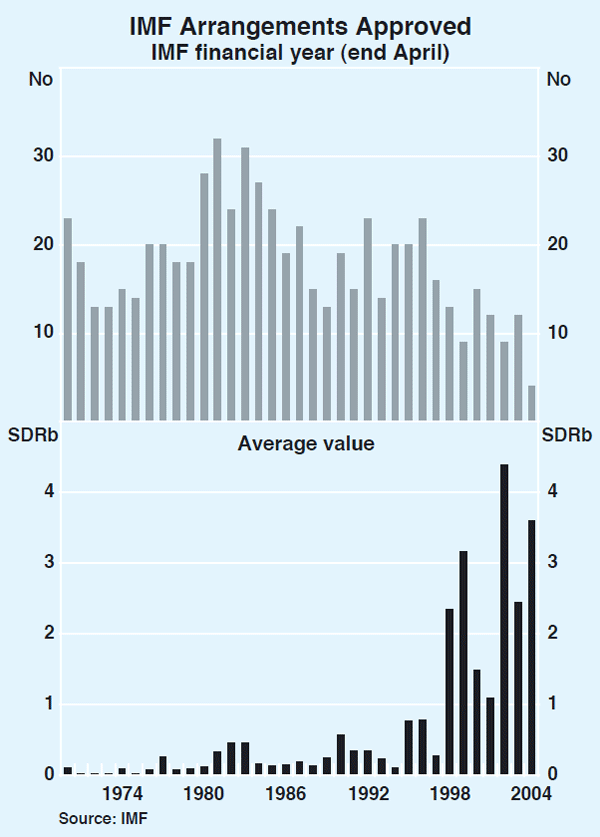
The net result of these divergent trends in the number and size of loans has been a significant increase in the total value of new lending arrangements approved. Average annual funding in the past decade was SDR21.5 billion (US$31.6 billion) up from only SDR4.5 billion in the previous 10 years (Graph 2). The average value has also increased relative to global GDP; after averaging 0.03 per cent of global GDP between the mid 1980s to mid 1990s, the average value of loan arrangements approved increased to 0.09 per cent of GDP over the past decade. This increase in the average value of new arrangements is likely to be related to the increase in global capital flows over recent decades, with economies vulnerable to larger outflows when they encounter financial difficulties.
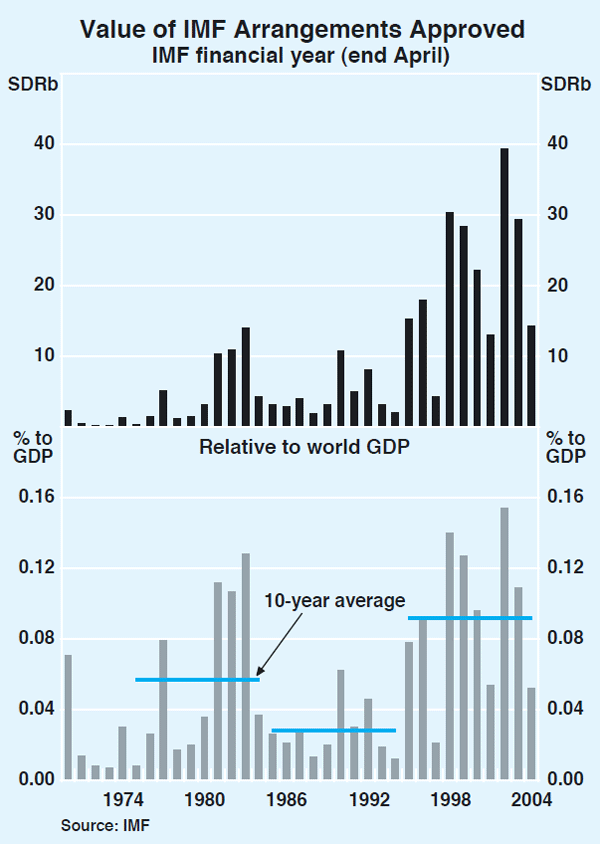
The increase in the average value of new lending has flowed through to a significant increase in the average level of IMF credit outstanding, which peaked at 0.3 per cent of global GDP in 1999 (Graph 3). While this peak was similar to that seen in 1985, following Latin America's major financial crisis, outstandings have remained at an elevated level through 2004 rather than falling relatively quickly as occurred in the late 1980s. This is due to the rolling nature of the regional crises over recent years, with the Asian crisis in 1997 and 1998 followed closely by the Russian crisis, and repeated episodes in Argentina, Brazil and Turkey.
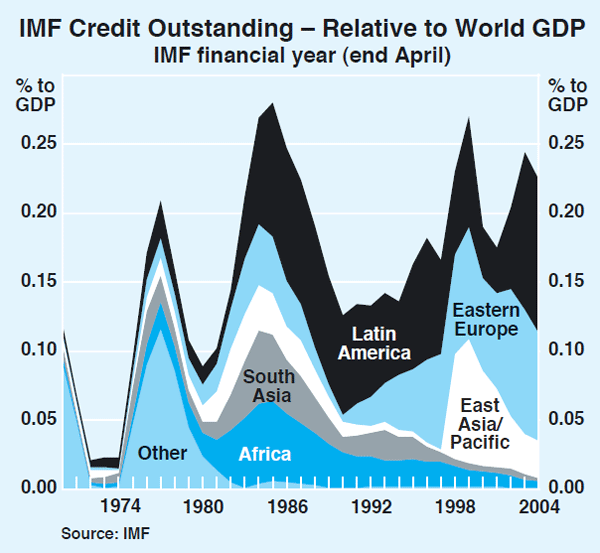
The 1997/98 Asian crisis resulted in large IMF programs for Thailand, Korea and Indonesia. In aggregate these programs accounted for almost all of the increase in the total value of new arrangements approved by the Fund in the year to end April 1998 (Graph 4). In that year, Thailand, Indonesia and Korea were granted loan facilities valued at SDR2.9 billion, SDR8.3 billion and SDR15.5 billion respectively. Indonesia, whose crisis proved to be more severe than first thought, later was given additional facilities in 1998 and 2000. Details of the various packages are shown in Table 1. As a result, east Asia's total credit outstanding jumped to 33 per cent of total IMF credit outstanding by 1999, up from previously negligible levels.
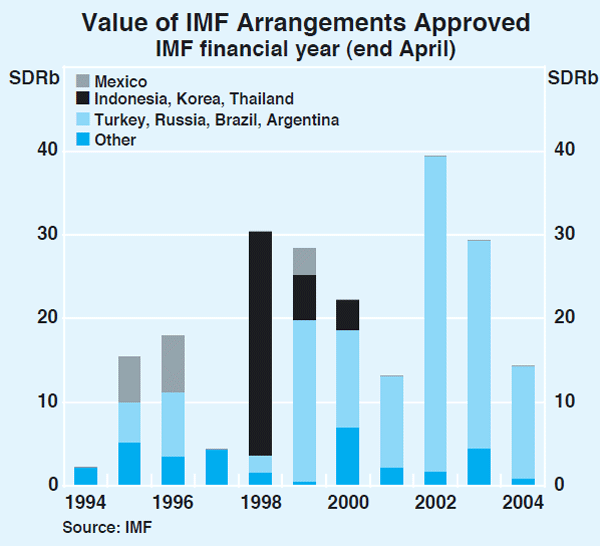
| Arrangement(a) | Date of arrangement | Amount approved | Amount drawn | Credit outstanding(b) |
|---|---|---|---|---|
| Thailand | ||||
| Stand-By | Aug 1997 | 2.9 | 2.4 | 0.0 |
| Total | 2.9 | 2.4 | 0.0 | |
| Indonesia | ||||
| Stand-By(c) | Nov 1997 | 8.3 | 3.7 | 0.0 |
| EFF | Aug 1998 | 5.4 | 3.8 | 3.1 |
| EFF | Feb 2000 | 3.6 | 3.6 | 3.6 |
| Total | 17.4 | 11.1 | 6.7 | |
| Korea | ||||
| Stand-By/SRF | Dec 1997 | 15.5 | 14.4 | 0.0 |
| Total | 15.5 | 14.4 | 0.0 | |
| Total | 35.7 | 27.9 | 6.7 | |
|
(a) Definitions of Stand-By Arrangements, the Extended Fund Facility (EFF)
and the Supplemental Reserve Facility (SRF) are in Box A. Source: IMF |
||||
Since then, in aggregate the Asian crisis economies have repaid their IMF debts ahead of schedule. With Korea fully repaying its borrowings from the IMF in 2001 and Thailand in July 2003, outstanding IMF loans to the Asian crisis countries had fallen to SDR6.7 billion at the end of March 2004. With Indonesia making its final drawing of IMF funds in December 2003, outstanding loans will continue to fall over the period ahead.
Following the Asian crisis, there were crises in Russia, Turkey, Argentina and Brazil. The total value of IMF loan arrangements to these economies was significantly more than that approved for the three Asian crisis countries in 1997 and 1998. Details of these assistance packages are shown in Table 2. The provision of SDR22.8 billion to Brazil in late 2002 was the largest single amount ever committed by the IMF to a member country. The September 2003 program for Argentina was particularly controversial. Prior to the approval of that arrangement Argentina had failed to meet a SDR2.1 billion repayment obligation to the IMF. Normally, countries are not allowed new borrowings from the IMF if they have overdue loan obligations. Argentina paid its overdue obligations once it received an assurance that a new program would be recommended for approval by the IMF.
| Arrangement | Date of arrangement | Amount approved | Amount drawn | Credit outstanding(a) |
|---|---|---|---|---|
| Argentina | ||||
| EFF | Mar 1992 | 4.0 | 4.0 | 0.4 |
| Stand-By | Apr 1996 | 0.7 | 0.6 | 0.0 |
| EFF | Feb 1998 | 2.1 | 0.0 | 0.0 |
| Stand-By(b) | Mar 2000 | 10.8 | 3.9 | 3.7 |
| SRF | Jan 2001 | 6.1 | 5.9 | 0.0 |
| Stand-By | Jan 2003 | 2.2 | 2.2 | 2.2 |
| Stand-By | Sep 2003 | 9.0 | 4.2 | 4.2 |
| Total | 34.9 | 20.7 | 10.5 | |
| Brazil | ||||
| Stand-By | Jan 1992 | 1.5 | 0.1 | 0.0 |
| Stand-By/SRF | Dec 1998 | 13.0 | 9.5 | 1.3 |
| Stand-By/SRF | Sep 2001 | 12.1 | 11.4 | 1.3 |
| Stand-By/SRF(C) | Sep 2002 | 27.4 | 17.2 | 15.5 |
| Total | 54.0 | 38.2 | 18.1 | |
| Russia | ||||
| Stand-By | Aug 1992 | 0.7 | 0.7 | 0.0 |
| Stand-By | Apr 1995 | 4.3 | 4.3 | 0.0 |
| EFF(d) | Mar 1996 | 9.2 | 5.1 | 2.9 |
| SRF | Jul 1998 | 4.0 | 0.7 | 0.0 |
| Stand-By | Jul 1999 | 3.3 | 0.5 | 0.1 |
| Total | 21.5 | 11.3 | 2.9 | |
| Turkey | ||||
| Stand-By | Jul 1994 | 0.6 | 0.5 | 0.0 |
| Stand-By(e) | Dec 1999 | 9.2 | 6.0 | 4.2 |
| SRF | Dec 2000 | 5.8 | 5.8 | 0.0 |
| Stand-By | Feb 2002 | 12.8 | 11.1 | 11.1 |
| Total | 28.5 | 23.3 | 15.3 | |
| Total | 138.9 | 93.5 | 46.8 | |
|
(a) As at March 2004 Source: IMF |
||||
As a result of these recent decisions, IMF lending has become concentrated in Brazil, Argentina and Turkey, with these three countries accounting for more than two-thirds of IMF credit outstanding (Graph 5). This is more than double that of Asian crisis countries at the time of the crisis. It is also the highest level of concentration of credit outstanding among the top three users of IMF resources seen since at least 1970. When credit outstanding previously peaked in 1985, the top three users accounted for just under one-third of total credit outstanding.
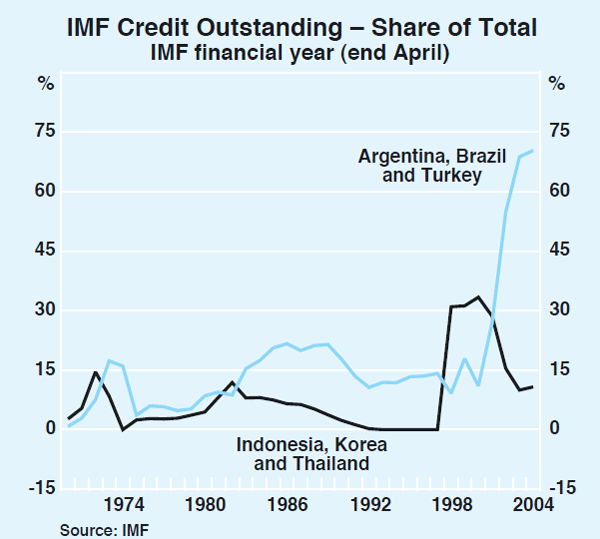
In response to the increased severity of crises, the IMF has widened the range of loan facilities available to members. An early step was the introduction of the Supplemental Reserve Facility (SRF) in late 1997, providing exceptional access to IMF resources by countries facing short-term capital outflows and which could potentially trigger contagion. Exceptional access refers to access to resources above the normal borrowing limits, which are a function of a country's capital subscription. The IMF also introduced Contingent Credit Lines (CCL) in 1999 as a precautionary line of defence for members against the contagion effects of capital account crises in other countries. The CCL was never used however, partly reflecting concerns by eligible countries that a request under this facility would be viewed as a sign of weakness rather than strength. The CCL was allowed to expire on its sunset date in November 2003. (A description of the lending arrangements offered by the IMF is given in Box A.) More recently, and against the background of an increase in the average size of assistance approved, the IMF introduced a new framework for countries seeking exceptional access to Fund resources. The framework sets out the criteria for determining when exceptional access to resources will be considered. The criteria for a country are: it is experiencing capital account pressure; has a high probability that debt will remain sustainable; there are prospects for re-entry into private markets; and there are strong prospects for success in delivering economic adjustment.
IMF Resources
The funds available to the IMF for lending are sourced from members' capital subscriptions, which are reviewed periodically. Not all these funds are usable by the IMF in its lending arrangements as a significant proportion is in the form of currencies which cannot be readily converted into the currencies desired by borrowers. This is largely because members contribute the bulk of their capital contributions in the form of their domestic currency. Some other holdings are not considered to be usable because they have already been committed to other borrowers or they are denominated in the currency of a country which has a weak or weakening balance of payments position.
The IMF has recently introduced a new measure to estimate resources available for financing activities in the year ahead, the one-year Forward Commitment Capacity (FCC). The FCC consists of uncommitted usable resources, plus projected repayments of loans one-year forward, less a prudential balance (Table 3). The prudential balance is set at 20 per cent of the value of the capital subscriptions of countries contributing to IMF support packages and is designed to safeguard the claims of creditor countries.
| 2001 | 2002 | 2003 | ||
|---|---|---|---|---|
| US $b | ||||
| Total resources | 217.1 | 218.1 | 219.1 | 326 |
| Members' currencies | 209.0 | 210.3 | 211.3 | 314 |
| SDR holdings | 1.5 | 1.2 | 1.1 | 2 |
| Gold holdings | 5.9 | 5.9 | 5.9 | 9 |
| Other assets | 0.7 | 0.8 | 0.9 | 1 |
| Less: Non-usable resources | 114.7 | 117.9 | 118.4 | 176 |
| of which: Credit outstanding | 53.5 | 63.6 | 65.0 | 97 |
| Equals: Usable resources | 102.5 | 100.2 | 100.7 | 150 |
| Less: Undrawn balances approved | 25.8 | 31.9 | 22.8 | 34 |
| Equals: Uncommitted usable resources | 76.7 | 68.3 | 77.9 | 116 |
| Plus: Repurchases one-year forward | 15.2 | 19.0 | 9.2 | 14 |
| Less: Prudential balance | 30.9 | 32.6 | 32.8 | 49 |
| Equals: One-year forward commitment capacity (FCC) | 61.0 | 54.7 | 54.2 | 81 |
|
Source: IMF |
||||
The FCC has fluctuated between a low of around SDR20 billion and a high of SDR70 billion since the early 1990s. Currently, it is around the high end of the range (Graph 6). Capital injections by members in 1992 lifted the FCC but in the second half of the 1990s it fell back sharply after the Mexican and Asian crises. A further capital subscription in 1999 again lifted the FCC. It peaked in 2000 at approximately SDR70 billion and has declined in the period since by about 20 per cent as a result of the increased lending to Argentina, Turkey and Brazil, partly offset by loan repayments by Asian countries.
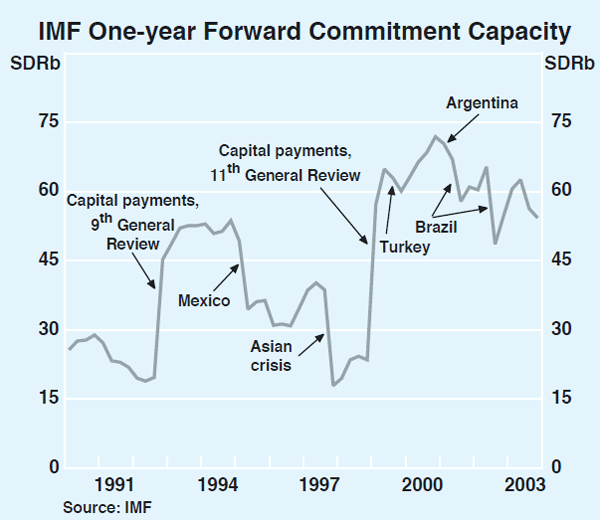
The introduction in 1998 of a new facility for the IMF to borrow from members, the New Arrangements to Borrow (NAB), provided an additional cushion to its resource position. The NAB allows the IMF to borrow specified amounts of currencies from 26 member countries including Australia. The NAB is in addition to the existing General Arrangements to Borrow (GAB), and would typically be the first and principal recourse in the event of a need to provide supplementary resources. The combined amount of resources available under the NAB and GAB is SDR34 billion.
Box A: IMF Financing Facilities for Countries with Balance of Payments Difficulties
The IMF has a number of different facilities available for dealing with temporary balance of payments difficulties. They differ in terms of the size of the facility, the period over which it can be drawn upon, and the repayment period once drawn. The main facilities are: Stand-By Arrangements, the Extended Fund Facility and the Supplemental Reserve Facility.
Stand-By Arrangements (SBAs) are used for overcoming balance of payments difficulties stemming from short-term problems. It is the most widely used facility of the IMF. SBAs have a maximum term of 4 years, with borrowings occurring in the first 2 years and final repayments expected at some point in the second half of the period. In some circumstances SBA borrowings may be made over a longer time period, for example Argentina's most recent SBA had a 3-year borrowing term.
The Extended Fund Facility (EFF) helps countries address more protracted balance of payments problems. The EFF has a typical borrowing term of 3 years and final repayments are expected up to 7 years after the loan is approved.
The Supplemental Reserve Facility (SRF) is used in situations where a country is facing large short-term capital outflows, in particular where such outflows have the potential to trigger contagion. It provides short-term financing above normal IMF borrowing limits (which are a function of each member's capital subscription), as a supplement to the SBA or EFF, but at a higher rate of interest. The SRF has a repayment period of 2 to 2½ years, but can be extended upon request for an additional six months.
In addition to the Fund's regular facilities, there are a number of special facilities available for countries facing particular circumstances, such as temporary shortfalls in export earnings, and emergency assistance in the aftermath of armed conflict or natural disaster.
Footnotes
This paper was prepared by Merylin Coombs, Paul Harvey and Dale Simpson of International Department. For a previous discussion of this topic at the time of the Asian financial crisis see ‘Box A: Financing Activities of the International Monetary Fund’ in the Semi-Annual Statement on Monetary Policy, RBA Bulletin, May 1998. Funding for low-income countries with longer-term problems, currently provided under the Poverty Reduction and Growth Facility, is excluded from the analysis and data presented. While the number of approvals each year for such funding is generally around the number approved for temporary balance of payments difficulties, the value of such approvals accounted for only 4 per cent of Fund approvals in financial year 2003. [1]
The SDR is the official currency of the IMF. The SDR's value is based upon a basket of currencies made up of the euro, Japanese yen, pound sterling and US dollar. Currently SDR1 = AUD2.05 = USD1.47. [2]